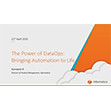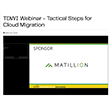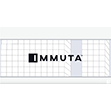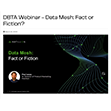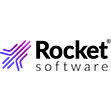

(TierneyMJ/Shutterstock)
Running a vector database in the cloud will be easier now that Pinecone is offering its vector database as a serverless offerings in Google Cloud and Microsoft Azure, to go along with an existing serverless product for AWS. The company also announced new enterprise features, including bulk import from object storage, among other features.
The advent of generative AI has supercharged the market for vector databases, which excel at storing, indexing, and storing vector embeddings. First used to bolster search with the power of nearest neighbor algorithms, companies today are scrambling to deploy vector databases as part of retrieval-augmented generation (RAG) setups that use pre-indexed vector embeddings to “ground” a large language model (LLM) with a customer’s own data.
Pinecone’s native vector database today is seeing a surge of interest from companies building GenAI applications, such as chatbots, question-answer systems, and co-pilots. As one of the older vector databases on the market (established 2019), Pinecone’s offering is well-regarded by analyst groups, and today’s announcements are likely to bolster that standing.
With serverless vector database offerings in all three major public clouds (it announced the general availability of its AWS serverless offering in May), Pinecone is positioned to capitalize on the current wave of investment in GenAI, much of which is occurring in the public cloud.
“Bringing Pinecone’s serverless vector database to Google Cloud Marketplace will help customers quickly deploy, manage, and grow the platform on Google Cloud’s trusted, global infrastructure,” Dai Vu, the managing director of marketplace and ISV go-to-market programs at Google Cloud, said in a blog today. “Pinecone customers can now easily build knowledgeable AI applications securely and at scale as they progress their digital transformation journeys.”
In addition to running its serverless offering on Microsoft Azure, Pinecone also integrates with the Azure OpenAI Service, which allows users to develop Gen AI applications faster by accessing OpenAI’s models and Pinecone serverless within the same Azure environment, Pinecone says. The company also notes that it has recently rolled out the first version of its .NET SDK, providing Azure developers the ability to build using native Microsoft languages.
In a typical serverless application, the customer is unburdened from worrying about the underlying server and the management thereof. But Pinecone’s serverless implementation goes beyond the typical setup, according to a blog post by Pinecone VP of R&D Ram Sriharsha earlier this year.
“Before Pinecone serverless, vector databases had to keep the entire index locally on the shards,” he writes in the January 16 blog post. “Such an architecture makes sense when you are running thousands of queries per second spread out across your entire corpus, but not for on-demand queries over large datasets where only a portion of your corpus is relevant for any query.”
“To drive order of magnitude cost savings to this workflow, we need to design vector databases that go beyond scatter-gather and likewise can effectively page portions of the index as needed from persistent, low-cost storage. That is, we need true decoupling of storage from compute for vector search.”
Pinecone also unveiled several new features in its serverless offerings today, new role-based access controls (RBAC); enhancements to backups; bulk import from object storage; and a new SDK.
The bulk import will lower the cost of the initial data load into Pinecone by 6x, the company says. That should help Pinecone customers ramp up their proofs of concepts (POCs) and production implementation.
“As an asynchronous, long-running operation, there’s no need for performance tuning or monitoring the status of your import operation,” Pinecone engineers Ben Esh and Gibbs Cullen write in the blog. “Just set it and forget it; Pinecone will handle the rest.”
Related Items:
Vectors: Coming to a Database Near You
Forrester Slices and Dices the Vector Database Market
August 1, 2025
- Micron Expands Storage Portfolio with PCIe Gen6 and 122TB SSDs for AI Workloads
- DataRobot Announces Agent Workforce Platform Built with NVIDIA
- Menlo Ventures Report: Enterprise LLM Spend Reaches $8.4B as Anthropic Overtakes OpenAI
- Confluent Announces $200M Investment Across Its Global Partner Ecosystem
- Zilliz Sets New Industry Standard with VDBBench 1.0 for Benchmarking Real Vector Database Production Workloads
- Symmetry Systems CSO Releases Book on Data Security Strategies for the AI Era
July 31, 2025
- Google DeepMind’s AlphaEarth Model Aims to Transform Climate and Land Monitoring
- Elsevier Launches Reaxys AI Search for Natural Language Chemistry Queries
- Boomi Brings Sovereign Data Integration to Australia
- Scality Releases Open Source COSI and CSI Drivers to Streamline File Storage Provisioning
- Informatica Boosts AI Capabilities with Latest Intelligent Data Management Cloud Platform Release
- Helix 2.0 Gives Global Enterprises the Fastest Path to AI Agents on a Private GenAI Stack
- Anaconda Raises Over $150M in Series C Funding to Power AI for the Enterprise
- Supermicro Open Storage Summit Showcases the Impact of AI Workloads on Storage
- Observe Closes $156M Series C as Enterprises Shift to AI-Powered Observability at Scale
- Stack Overflow’s 2025 Developer Survey Reveals Trust in AI at an All Time Low
July 30, 2025
- Elastic Announces Faster Filtered Vector Search with ACORN-1 and Default Better Binary Quantization Compression
- Nutanix Named a Leader in Multicloud Container Platforms Evaluation
- RAVEL Expands Orchestrate AI With Supermicro-Based AI Workload Solution
- MLCommons Releases MLPerf Client v1.0: A New Standard for AI PC and Client LLM Benchmarking
- Scaling the Knowledge Graph Behind Wikipedia
- LinkedIn Introduces Northguard, Its Replacement for Kafka
- Top 10 Big Data Technologies to Watch in the Second Half of 2025
- Apache Sedona: Putting the ‘Where’ In Big Data
- Rethinking AI-Ready Data with Semantic Layers
- What Are Reasoning Models and Why You Should Care
- Top-Down or Bottom-Up Data Model Design: Which is Best?
- Rethinking Risk: The Role of Selective Retrieval in Data Lake Strategies
- What Is MosaicML, and Why Is Databricks Buying It For $1.3B?
- LakeFS Nabs $20M to Build ‘Git for Big Data’
- More Features…
- Supabase’s $200M Raise Signals Big Ambitions
- Mathematica Helps Crack Zodiac Killer’s Code
- Promethium Wants to Make Self Service Data Work at AI Scale
- Solidigm Celebrates World’s Largest SSD with ‘122 Day’
- AI Is Making Us Dumber, MIT Researchers Find
- Toloka Expands Data Labeling Service
- The Top Five Data Labeling Firms According to Everest Group
- With $20M in Seed Funding, Datafy Advances Autonomous Cloud Storage Optimization
- Ryft Raises $8M to Help Companies Manage Their Own Data Without Relying on Vendors
- AWS Launches S3 Vectors
- More News In Brief…
- Seagate Unveils IronWolf Pro 24TB Hard Drive for SMBs and Enterprises
- Gartner Predicts 40% of Generative AI Solutions Will Be Multimodal By 2027
- OpenText Launches Cloud Editions 25.3 with AI, Cloud, and Cybersecurity Enhancements
- TigerGraph Secures Strategic Investment to Advance Enterprise AI and Graph Analytics
- Promethium Introduces 1st Agentic Platform Purpose-Built to Deliver Self-Service Data at AI Scale
- StarTree Adds Real-Time Iceberg Support for AI and Customer Apps
- Gathr.ai Unveils Data Warehouse Intelligence
- Databricks Announces Data Intelligence Platform for Communications
- Graphwise Launches GraphDB 11 to Bridge LLMs and Enterprise Knowledge Graphs
- Informatica Named a Leader in the 2024 Gartner Magic Quadrant for Data Quality Solutions 16 Consecutive Times
- More This Just In…
















